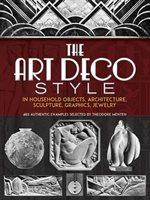Art Deco garden and terraces; Art Deco dwellings, including the Bauhaus faculty residences designed by Walter Gropius; Art Deco interiors; Art Deco furniture, with chairs by Le Corbusier, Marcel Breuer, and P. Jeanneret; Art Deco metalwork, including the elevator shaft of the Grunfeld Department Store, lighting fixtures, lettering, locks, and folding screens; Art Deco shops and department stores; Art Deco buildings; Art Deco stained glass, including the window wall in the Bally Shoe Store; Art Deco sculpture; Art Deco dishes, flatware, tea services, cut crystal bottles, mirrors, and case; Art Deco jewelry; Art Deco ornamental sculpture; and more. These are among the many facets of the prismatic, geometrical Art Deco style that captured the 1920s and '30s. This new selection of Art Deco styles includes works in all of the above categories from 175 artists, architects, and designers, including Edgar Brandt, Marcel Breuer, Pierre Chareau, Jean Fouquet, Gabriel Gu vr kian, Le Corbusier, Pierre Legrain, Andr Lur at, Robert Mallet-Stevens, the Martels, Gustave Miklos, Charles Moreux, Raymond Nicholas, Charlotte Perriand, Jean Puiforcat, Rebe-Herbst, G rard Sandoz, Henri Sauvage, Raymond Subes, and Gaston Vuitton. The selection is primarily from L'Art International d'Aujourd'hui (International Art of Today), the already rare 20-volume work containing the authentic documents of the movement. Although the influences are many? Egyptian and Aztec art, Cubism, Fauvism, and Expressionism? the goal "to unite arts with industry" and the strongly geometric outlook are common. The Art Deco movement did not stop in the 1920s and '30s however. It is still very important for present-day design. For the finest illustrations, whether you are searching for inspirations for designs or for a better look at the very important style of the '20s and '30s, this book will provide you with a true picture of the Art Deco style.


